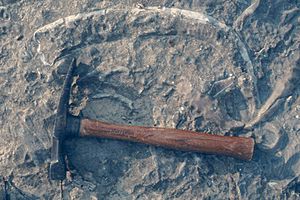Jeffersonville Limestone facts for kids
Quick facts for kids Jeffersonville LimestoneStratigraphic range: Devonian |
|
|---|---|

Large rugose coral (above hammer) in the Jeffersonville Limestone at the Falls of the Ohio
|
|
| Type | sedimentary |
| Unit of | Muscatatuck Group |
| Sub-units | Dutch Creek Sandstone Member, Geneva Dolomite Member, Vernon Fork Member |
| Underlies | North Vernon Formation and Sellersburg Limestone |
| Overlies | Clear Creek Chert and Louisville Limestone |
| Thickness | 20 ft at Louisville, KY, 0 to 61 m in southwest Indiana |
| Lithology | |
| Primary | limestone |
| Location | |
| Region | Cincinnati Arch |
| Country | United States |
| Extent | Indiana, Kentucky |
| Type section | |
| Named for | Jeffersonville, Indiana |
| Named by | Edward M. Kindle, 1899 |
The Jeffersonville Limestone is a special type of rock found in Indiana and Kentucky. It formed during the Devonian Period, which was a very long time ago! This rock is famous because it's packed with amazing fossils.
Contents
What is Jeffersonville Limestone?
The Jeffersonville Limestone is a type of rock called limestone. It's usually dark gray and feels a bit rough, like coarse sand. This rock forms in thick layers, almost like stacked pancakes. It's also full of fossils, which are the preserved remains of ancient plants and animals.
Scientists have studied the Jeffersonville Limestone carefully. They've even divided it into different sections, or "zones," based on the types of rocks and fossils found in each layer. These zones help them understand how the environment changed over time.
Amazing Fossils in the Jeffersonville Limestone
The Jeffersonville Limestone is super famous for its many fossils. You can see lots of them, especially corals, at a place called the Falls of the Ohio. Many of these corals are still in the same spot where they grew millions of years ago!
In 1899, a scientist named Edward Kindle described many different kinds of fossils found at the Falls of the Ohio. Here are some of the cool creatures he found:
- Brachiopods: These were sea creatures with two shells, a bit like clams, but they are a different animal group. Some examples include Atrypa aspera and Spirifer acuminatus.
- Rostroconchs: These were ancient sea animals that had a single shell.
- Corals: These are marine animals that often live in colonies and build hard skeletons. Examples include Favosites hemisphericus and Zaphrentis giganteus.
- Gastropods: These are snails, both land and sea snails. Platyceras dumosum is one example.
- Bivalves: These are sea creatures with two hinged shells, like modern clams or oysters. Actinopteria boydi is an example.
- Trilobites: These were ancient sea arthropods, like distant relatives of crabs or insects. Proetus canaliculatus was one type found.
Later, in 1955, other scientists named Campbell and Wickwire found even more fossils in the Jeffersonville Limestone near Hanover, Indiana. Their discoveries included:
- Corals: Such as Heliophyllum halli and Hexagonaria prisma.
- Bryozoa: Tiny colonial animals that often look like moss or lace.
- Gastropods: Like Platyceras dumosum.
- Brachiopods: Including Paraspirifer acuminatus.
- Bivalves: Such as Glyptodesma occidentali.
- Crinoids: These are marine animals often called "sea lilies" because they look like plants.
- Trilobites: Phacops rana is a well-known type of trilobite found here.
- Cephalopods: These are marine animals like modern octopuses or squids, but ancient ones often had shells, like Gyroceras indianense.
Other types of trilobites found in this rock include Arctinurus sp. and Greenops kindlei.
Tiny creatures called Ostracods, which are like small crustaceans with two shells, were also found. Scientists Kesling and Peterson documented them in 1958.
Even Blastoids, which are ancient sea creatures related to starfish and sea urchins, have been found. Codaster alternatus and Codaster pyramidatus are examples identified at the Falls of the Ohio.
Where Can You See It?
The best place to see the Jeffersonville Limestone is at Falls of the Ohio State Park. This park is located near Louisville, Kentucky. It's a fantastic spot to explore and see all the amazing fossils for yourself!
How Old is This Rock?
Scientists use different methods to figure out how old rocks are. For the Jeffersonville Limestone, they've determined it formed during the early to middle part of the Devonian Period. This means it's incredibly old, dating back millions of years!

